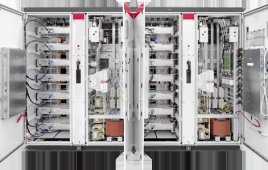AMSC, a global energy solutions provider serving wind and power grid industry leaders, has announced four new D-VAR STATCOM system orders valued at about $8 million. All four orders serve the renewable energy sector. The systems are expected to be used to connect wind power plants to the electric grid, as well as to provide voltage regulation by responding dynamically to varying load conditions. Revenue from these four D-VAR orders is expected to be recognized in fiscal year 2017.
AMSC’s D-VAR interconnection and reactive power compensation solutions are designed to ensure high network performance and stability. The system is a powerful, cost-effective way to provide continuous voltage regulation, improve voltage stability, meet interconnection requirements, and dynamically provide grid support where it is needed.
 “We are pleased with these orders for our Reactive Power business and believe they evidence the momentum in our Grid segment,” said Daniel P. McGahn, President and CEO, AMSC. “We believe these new D-VAR orders demonstrate the benefits of our solutions and relationships with wind farm developers in our core geographies such as the U.S., U.K., and Australia, as well as new territories such as the Middle East.”
“We are pleased with these orders for our Reactive Power business and believe they evidence the momentum in our Grid segment,” said Daniel P. McGahn, President and CEO, AMSC. “We believe these new D-VAR orders demonstrate the benefits of our solutions and relationships with wind farm developers in our core geographies such as the U.S., U.K., and Australia, as well as new territories such as the Middle East.”
Customers use AMSC’s D-VAR solutions to provide dynamic voltage control, power factor correction, and post-contingency reactive compensation to stabilize the power grid and prevent undesirable events such as voltage collapse. The D-VAR system is designed to be able to detect and instantaneously compensate for voltage disturbances by dynamically injecting leading or lagging reactive power into the power grid. These solutions are also designed to augment the overall performance of wind farms and to enable developers to meet grid interconnection requirements.
D-VAR reactive compensation systems are classified as Static Compensators, or “STATCOMs,” a member of the FACTS (Flexible AC-Transmission System) family of power electronic solutions for alternating current (AC) power grids.
Filed Under: Transformers





